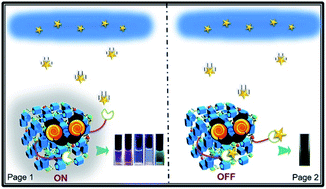A color-tunable fluorescent pillararene coordination polymer for efficient pollutant detection†
Abstract
A dicarboxylatopillar[5]arene (DCP5)-based coordination polymer, namely DCP5-EuxTby, with color-tunable emission and capable of nitroaromatic pollutant detection, has been designed and fabricated via a typical metal–ligand coordination approach. Due to its rigid skeleton and electron-rich cavity, DCP5 plays an important role in this multi-color framework, not only as a linker but also as a blue-color fluorescence donor. Intriguingly, the fluorescent color of DCP5-EuxTby can be tuned from green to red simply by mediating the molar ratio of Eu3+ : Tb3+ in the functional system. More importantly, a white-color emitting system, that is, DCP5-Eu1Tb3, is discovered when the ratio of Eu3+ : Tb3+ is 1 : 3, and the white-light emissive DCP5-Eu1Tb3 exhibits good detection performance toward nitroaromatic pollutants in a wide application field. We envision that this work will open a new avenue for the exploration of synthetic macrocycle-based new materials in the construction of new fluorescent sensors and detectors for environmental sustainability and bio-related fields.

- This article is part of the themed collection: 2020 Journal of Materials Chemistry A most popular articles


 Please wait while we load your content...
Please wait while we load your content...